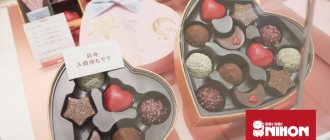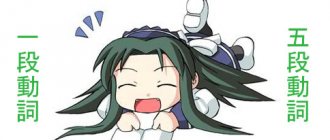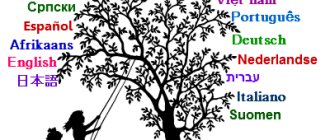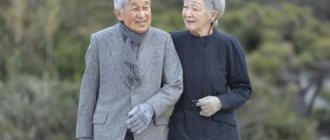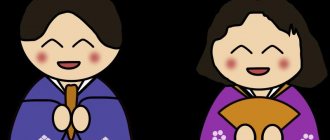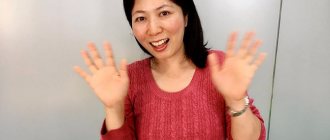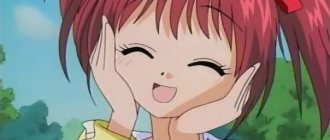Voiced consonants
Voiced consonants are consonant sounds that require voicing, vibration of the vocal cords.
The consonants "k", "s", "t" and "x" in Hiragana and Katakana are turned into a voiced "double" by using two small strokes in the upper right corner of the symbol. Semi-voiced consonant “p” - using a small circle in the upper right corner of the symbols of the “x” group. Voiced Hiragana - pronunciation by click
| P | b | d | h | G | |
| ぱ | ば | だ | ざ | が | A |
| ぴ | び | ぢ (ji) | じ (ji) | ぎ | And |
| ぷ | ぶ | づ (zu) | ず | ぐ | at |
| ぺ | べ | で | ぜ | げ | uh |
| ぽ | ぼ | ど | ぞ | ご | O |
Voiced katakana - pronunciation by click
| P | b | d | h | G | |
| パ | バ | ダ | ザ | ガ | A |
| ピ | ビ | ヂ (ji) | ジ (ji) | ギ | And |
| プ | ブ | ヅ (zu) | ズ | グ | at |
| ペ | ベ | デ | ゼ | ゲ | uh |
| ポ | ボ | ド | ゾ | ゴ | O |
Greetings, Friends. Igor Korotkov is with you. You are on the website Venasera.ru. Today we will talk about Onny and Kun readings in Japanese .
Hieroglyphs (Kanji) were borrowed from China in ancient times and the Japanese used them for their own needs.
The Japanese language did not have a writing system until the introduction of kanji, Chinese characters, in the late 5th century.
Kanji漢字 literally translates to " Han Letters ". This is such a Chinese dynasty.
Unlike the Japanese syllabary alphabet Hiragana and Katakana , which in themselves do not mean anything, each character has at least one , if not several meanings .
Most characters in Japanese have at least 2 readings : On'yomi and Kun'yomi , so-called. onny and kunny readings.
Onny readings 音読みare Chinese readings that were borrowed by the Japanese from the Chinese along with hieroglyphs. Because Since the phonetics of Japanese and Chinese are very different, the Japanese pronounced borrowed pronunciations in their own way, and this is how ononic reading .
If a character was borrowed more than once, entering the Japanese language in different historical periods or from different Chinese dialects, it may have several “Chinese” reading options, which reflect its sound in different historical periods and in different dialects of the Chinese language. For example, the character “to go” 行 has as many as three “Chinese” readings in Japanese.
Kun reading 訓読みis a native Japanese word to which one or another hieroglyph was assigned. Those. The Japanese had the word Ki, and they simply assigned it to the hieroglyph tree.
Therefore, usually ( but not always ), characters in Japanese have at least two readings: Chinese onnoe and Japanese kunnoe .
Now let's figure out when we usually use onny reading, and when we use kunnoe.
Usually, words consisting of 1 hieroglyph are read according to KUN READINGS , and words consisting of 2 or more hieroglyphs are read according to ONLY READINGS . For example: the word “man” consists of 1 hieroglyph , so it is read according to the Kun reading – “ Hito ”. If we see a word made up of 2 or more hieroglyphs, then we read the word according to its readings , for example, the word “Student” consists of 2 hieroglyphs学生. It will be read as GakuSei - “Student”.
However, as we know, in the Japanese language there are a bunch of different exceptions for each rule, so there are quite a few such exceptions here, for example: the word Hon本 - a book, consists of only 1 hieroglyph, but is read exactly like Hon (according to its reading), not Moto . As part of the surname , and the vast majority of surnames consist of exactly two hieroglyphs , the hieroglyphs are usually read according to kun reading , i.e. in our example we will read this kanji as Moto . The ratio of readings of surnames according to kun and on readings is approximately 80% to 20%.
In some words, one part of the hieroglyph is read according to the onny reading, and the other according to the kun reading. For example, the same words Onyomi 音読みand Kunyomi 訓読みare read exactly this way. The first part is onny reading, the second part is kun reading. Also, quite often you can find words consisting of 2 hieroglyphs, but at the same time they are read precisely according to kun readings.
Try to adhere to logic: a word consisting of 1 hieroglyph is read in kunas, a word consisting of 2 or more hieroglyphs is read in onams, but do not forget to look in the dictionary to check, because There are a lot of exceptions to this point.
That's all for today. If you liked the video, like it, tell your friends, subscribe to the channel, and also to our groups on social media. Networks, Igor Korotkov was with you. See you in the next video!
Syllables with 「や」、「ゆ」 and 「よ」
Diminished 「や」、「ゆ」 and 「よ」 with the symbols “consonant+i” form the following syllables:
All combinations with reduced や、ゆ and よ in hiragana - pronunciation by click
| P | b | h | G | R | m | X | n | ts | With | To | |
| ぴゃ | びゃ | じゃ | ぎゃ | りゃ | みゃ | ひゃ | にゃ | ちゃ | しゃ | きゃ | I |
| ぴゅ | びゅ | じゅ | ぎゅ | りゅ | みゅ | ひゅ | にゅ | ちゅ | しゅ | きゅ | Yu |
| ぴょ | びょ | じょ | ぎょ | りょ | みょ | ひょ | にょ | ちょ | しょ | きょ | e |
All combinations with reduced や、ゆ and よ in katakana - pronunciation by click
| P | b | h | G | R | m | X | n | ts | With | To | |
| ピャ | ビャ | ジャ | ギャ | リャ | ミャ | ヒャ | ニャ | チャ | シャ | キャ | I |
| ピュ | ビュ | ジュ | ギュ | リュ | ミュ | ヒュ | ニュ | チュ | シュ | キュ | Yu |
| ピョ | ビョ | ジョ | ギョ | リョ | ミョ | ヒョ | ニョ | チョ | ショ | キョ | e |
6) Doubling voiceless consonants
The small sign [っ] doubles the consonant sound that follows it: ちょっと → te tt
o (more correctly through a light “h”: chetto) / a little, a little きって → ki
tt
e / postage stamp きっぷ → ki
pp
u / ticket つっこむ → tsu
kk
omu / immerse yourself, delve into We recommend moving on to the next lesson and practicing everything reading rules.
Learn Japanese on your own with us! Test and consolidate your knowledge on our resource! If you liked this Lesson, share it with your friends or save it to your wall
^^
Source
Hard consonants
Apart from 「ん」, no original syllable ends with a consonant. Diminished 「つ」 adds a consonant from the following syllable to the syllable. With the consonants “p”, “k”, “t” and “s” this creates a solid pause.
For example, 「ひと」 (“person”) is pronounced “hi-to.” But in 「ひっと」 the consonant “t” is doubled, which leads to the pronunciation “hit-to” (“hit”, from the English hit).
More examples:
- トラック (to-rak-ku) - truck (from English truck)
- ざっし (zas-si) - magazine
- カップ (kap-pu) - cup (from English cup)
3) Formation of voiced and voiceless consonants
[゛] – nigori. It is added to signs with a voiceless consonant sound, converting it into a voiced sound.
[゜] – maru.
Forms signs with the consonant [n].
Maru is placed only at the は row. These signs are placed above the main symbol. か → が ga き → ぎ gi く → ぐ gu け → げ ge こ → ご go
さ → ざ za し → じ ji (with buzzing) す → ず zu せ → ぜ ze そ → ぞ zo
た → だ da ち → ぢ ji (with buzzing) つ → づ zu て → で de と → ど do
は → ば ba ひ → び bi ふ → ぶ bu へ → べ be ほ → ぼ bo
は → ぱ pa ひ → ぴ pi ふ → ぷ pu へ → ぺ pe ほ → ぽ po
Long vowel sound
A long vowel is made by increasing the duration of the vowel sound.
In writing, to do this, add 「あ」、「い」 or 「う」 to the vowel, according to the table: Lengthening vowel sounds
| Vowel | Extension with |
| / A / | あ |
| / and / e / | い |
| /u/o/ | う |
To lengthen the vowel sound in 「か」, add 「あ」 to it to make 「かあ」. More examples: 「き → きい」, 「く → くう」, 「け → けい」, 「こ → こう」, 「さ → さあ」, etc. The reason for this is simple. Try saying 「か」 and 「あ」 first separately, then in a row as quickly as you can. You will find that it is much easier to stretch the vowel.
It is important that the full duration of both characters is preserved: many similar words differ only in the length of the vowels. For example, 「ここ」 means “here” and 「こうこう」 means “high school.”
Below is a small list of example words with a long vowel. The long vowel is highlighted in a different color:
- がくせい (ga-ku-se) - student
- せんせい (sen-se) - teacher
- きょう (kyo) - today
- おはよう (o-ha-yo) - good morning
- おかあさん (o-ka-san) - mother
We will look at examples of exceptions when 「え」 is added to lengthen “e” or “o” is lengthened with 「お」.
In katakana, lengthening vowels is much easier. Use this trait: 「ー」.
- ツアー (tsu-a) - tour (from English tour)
- メール (me-ru) - email (from English mail)
- ケーキ (ke-ki) - cake (from English cake)
Pronunciation difficulties. Hiragana alphabet
Often, when studying a foreign language, in the process of practicing with a native speaker, we are faced with what seems to us to be an incorrect perception of what we said (we say and mean one thing, but the interlocutor (native speaker) hears and understands something else). And the problem, as it later turns out, is not at all in the scarcity of our vocabulary (vocabulary), but in the phonetic component.
Japanese, like many others, has certain sounds that, if mispronounced, can significantly affect how native speakers understand your speech. This kind of difficulty is caused by the following eight hiragana sounds:
1.Soundわ – transcription reading in Japanese [wa] (in Russian the combination “ua” has a similar effect). Native speakers of Russian often pronounce this sound in the Russian manner, that is, “va”. Therefore, in the flow of speech, words such as: wakawakashii (young, young) are perceived by native Japanese speakers as: bakabakashii (ridiculous, absurd).
Wakawakashii = huakahuakasii; wakawakashii ≠ wakawakashii.
2. The soundんis a dull stop. It is often not pronounced at the end of a sentence. In the middle of a sentence it can be pronounced as [m] (senpai = sempai - addressing a senior in the course).
3. Soundらand all its derivatives. There is no [r] sound in Japanese. Actually, like the sound [l]. But there is, so to speak, an intermediate sound between [r] and [l] (closer to [l]).
When we pronounce the Russian sound “l”, the tip of the tongue rests against the back wall of the upper teeth, but to make this sound resemble Japanese, when pronouncing the Russian sound “l”, we move the tip of the tongue to the alveoli, so that it only lightly touches them ( see fig.).
4. Soundふ– transcription reading [fu] (like the Russian “fu”). Pronounced weakly, as you exhale.
5. Soundす– similar to the Russian weak, hissing sound “sy”. When pronouncing the Russian sound “su”, we move the tip of the tongue to the alveoli (see figure).
6. Soundよ– rounded, middle row. When pronouncing this sound, the tongue occupies a slightly lower position than when pronouncing the Russian sound “ё”.
7. Soundう– unrounded, front row. When articulating this sound, we pronounce the Russian sound “u” and slightly pull our lips back.
8. Soundsおandを– the difference in the pronunciation of these sounds is small.
The soundおis similar to the Russian sound “o”, but when forming this vowel, the language occupies a lower position than in a similar Russian sound.
The soundをis a weak, mid-rounded sound [wɔ] (in Russian the combination “uo” would be similar to this sound).
From the link given below, you can listen to the original pronunciation of all the hiragana sounds and practice their pronunciation.
Source
Additional katakana sounds
「ふ」 is the only syllable with an “f” sound: 「ふとん」 (futon) or 「ふじ」 (Fuji). And this is normal in Japanese, which has no other “f” words with syllables like “fa,” “fi,” or “fo.” This became a problem when borrowing foreign words like “fork”.
The problem was solved by using reduced vowel symbols. Thus, a small 「ォ」 attached to 「フ」 gives 「フォ」 (“fo”). Therefore, "fork" is written as [フォーク」. Other gaps were also closed in this way. "v" sounds are also expressed in writing by adding two strokes to the vowel 「ウ」, but are rarely used due to the difficulty of pronunciation for native Japanese speakers.
Gaps in Katakana that are so filled:
Additional sounds
| in (v) | in (w) | f | h | d | T | h | w | |
| ヴァ | ワ | ファ | チャ | ダ | タ | ジャ | シャ | A |
| ヴィ | ウィ | フィ | チ | ディ | ティ | ジ | シ | And |
| ヴ | ウ | フ | チュ | ドゥ | トゥ | ジュ | シュ | at |
| ヴェ | ウェ | フェ | チェ | デ | テ | ジェ | シェ | uh |
| ヴォ | ウォ | フォ | チョ | ド | ト | ジョ | ショ | O |
- ソファ (so-fa) - sofa
- ウィンドウズ (win-do-u-zu) - Windows (as in MS Windows)
- ウォッカ (vok-ka) - vodka
- チェック (chek-ku) - control (from English check)
Phonetics in Japanese
The phonetics of the Japanese language can seem complex and confusing to beginners. The fears are partly justified: it arose and was formed not according to the usual algorithms for the development of literature, in other cultural conditions. It will not be possible to find similarities in the pronunciation or spelling of Russian and Japanese words, as, for example, in the Slavic or Romance groups. However, researchers admit that the Japanese-Ryukyuan family of languages is not the most difficult to study.
The habit of following the rules of logic, inherent in the nation, was reflected in the language of the Land of the Rising Sun. There are no cases here where “o” is written, but “a” is pronounced: a Japanese person will never read “harasho” instead of the written “good”. And the situation typical for the French language, when “onion” is read instead of “oignon”, can drive him crazy!
In Japan, they speak Hyojungo, the generally accepted literary language of the country. But in everyday life, the regional dialect is more often used. Differences in pronunciation do not affect the life of society, since school instruction is conducted exclusively in hyojungo. We will analyze the standard version of phonetics.
Pronunciation in hyojungo is clear and understandable. Almost all syllables are open - they consist of a consonant and a vowel. Closed syllables are less common and always end in n. Phonetically, the languages differ: Japanese does not have some of the sounds that are in Russian. Some are something intermediate between two consonant letters (for example, “r”, “l”).
Unlike Europe, there is not one, but three types of generally accepted writing: hiragana, katakana and hieroglyphs - kanji. The first two alphabets have the same sound, but are written differently.
Hiragana is the “native” syllabary alphabet for the written designation of words of Japanese origin: particles, inflected parts of adjectives, verbs, nouns. Katakana is the alphabet of “borrowings” used to denote words that came from other cultures: proper names, nouns with foreign roots, technical and scientific terms, concepts. Kans (syllables) have a certain sound and are a common alphabet, the same as the Cyrillic and Latin alphabet. Print media often use all three types of writing, giving rise to the concept of "mixed writing".
Another type of writing is Romaji. It is not used as widely as the other three varieties, but it allows texts to be written in Latin.
Japanese phonetics has 22 sounds - 15 consonants, 2 semivowels, 5 vowels:
How many letters are in the Japanese alphabet?
Japanese writing combines three systems for graphic communication. To study them for the uninitiated is an art. To begin with, it is good to know the basics, or the alphabet.
The Japanese use two syllabaries created by their ancestors: hiragana and katakana, as well as kanji, which consists of Chinese characters.
Hiragana and katakana contain 47 characters. These systems are known for the fact that behind one character there is hidden not just one sound, but a whole syllable: for example, when we have 4 letters in the word “snow”, in Japanese graphics there will be 2. This system is also called syllabic writing.
How many vowels are there in the Japanese alphabet?
There are no separate vowels in Japanese. The Japanese usually use open syllables with 5 vowel sounds. Romanized, they look like this:
- A – similar to Russian [a], which stands between two consonants.
- I – [and], before it all consonants become soft.
- U is the middle sound between [u] and [s]. The lips do not stretch out, as when pronouncing a similar Russian sound. The lips are slightly rounded and the tongue moves back.
- E – always clear [e]. The consonants preceding it remain hard.
- O – always clear[o]. In an unstressed position it does not transform into [a]. The lips become slightly rounder, but do not extend forward.
Japanese has semivowels: [y] and [w].
Diphthongs are also used in Japanese writing:
- ai [ai];
- oi [oh];
- ui [ui];
- ei [hey], today is often replaced by a long [e].
All of them are falling: the first vowel sounds clearer than the second.
Instead of forceful stress, the Japanese use tonication for vowels and syllables. There are three types of toning:
- flat;
- rising;
- decreasing.
How many consonants are there in the Japanese alphabet?
There are no separate consonant letters other than ん (H) in Japanese. The remaining characters are syllables ending in a vowel. However, there are analogues of sounds:
- [To];
- [G];
- [With];
- [dz] - the sound is interesting because it is pronounced almost the same as [z], but at the same time the ligaments are tensed. The sound [z] itself also occurs in speech, only always in the middle of a word;
- [T];
- [d];
- [ts];
- [X];
- [f] - differs from Russian pronunciation in that it makes a sound more like blowing out a candle; the lips do not extend, and the lower lip rises slightly above the upper;
- [P];
- [b];
- [m];
- [R];
- and the above named [n].
When one of the consonants K, S, T, C, P, N, M, CH needs to be doubled, a special symbol is used - sokuon. Such doubling of a consonant is not accidental; thanks to this, the meaning of the word itself changes.
Japanese allows consonants to be long and short. The long ones will be:
- The long consonants themselves. They appeared as a semantically distinctive feature of speech and writing.
- Double consonants. When in some words there was a reduction of [u] and [i] between two voiceless consonants, the consonants that were once separated by a vowel became double, as in the word KOKKI (originally: KOKUKI) - the national flag.
- There are also emphatic long consonants, when a person voluntarily increases the pronunciation of a sound.
The peculiarity of the letter ん (N) is that before the consonant sounds [p], [p'], [b], [b'], [m], [m'], [n], [n'] expresses labiolabial nasal sound and almost transforms into [m]. This is also reflected in the letter, when the letter M appears in place of H. Both graphic notations are considered the norm.
How to understand the variety of Japanese alphabet systems?
In Japan, printed materials often use hiragana, katakana and kanji simultaneously, which gave rise to the concept of “mixed script”. Thus, newspaper headlines, thanks to this, can occupy several lines, although they contain only one sentence. To distinguish between symbol systems, you need to remember a few rules:
- Kanji is usually used to represent nouns, adjectives and verb stems. Its symbols are often used to represent morphemes in writing.
- Hiragana represents one syllable, or mora, with each character. Hiragana is used to convey vowel sounds, syllable combinations, and consonants. N. Hiragana conveys particles and suffixes in writing. It is also used to provide hints for learning hieroglyphs. Hiragana is also called “women’s writing” because Japanese women, who had long been confined to home education, kept notes with its help. Today, Harigana is used for preschool reading texts.
- Katakana, which was created by Buddhist monks, expresses the same sounds as harigana. The signs of this alphabet are used today for symbols taken from other cultures, foreign names, scientific and technical terminology.
- Travelers will not have to understand the intricacies of Japanese alphabet. For tourists, they created a special writing style - romaji. It also has its own groups, but the most important thing is that it allows you to write Japanese texts in Latin letters. Romaji is used in tourist brochures, on landmark signs, and anywhere a visitor to the country might find themselves.
- Traditionally, the Japanese write vertically, but already in 1959 the principle of horizontal writing was adopted at the state level.
Video on the topic
Toning
Intonation emphasis and stress, characteristic of Russian speech, are replaced here by tonization. The stress unit - mora - corresponds to a short syllable or half of a long one.
Linguists distinguish three types of tonization:
Changes in tone can change the meaning of a word or an entire phrase. It is difficult for foreigners to get used to this feature: the strong first syllable in the word kawa corresponds to the translation “river”, and the second one means “interesting story”. The same effect is observed in the word toru (to:ru) - depending on the length of the first syllable, it means “to pick up” or “to pass through.”
The missing sound in Japanese phonetics is equal in length to other characters, and in transcription it is designated by the double consonant that comes next. There are two rules for the pronunciation of such gaps: some are pronounced as a pause, while others are pronounced as a double consonant. Both options are acceptable.


